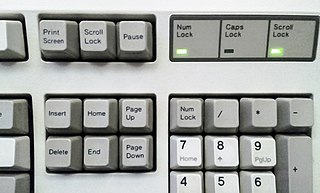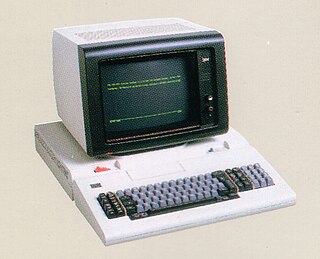Related Research Articles

The IBM 3270 is a family of block oriented display and printer computer terminals introduced by IBM in 1971 and normally used to communicate with IBM mainframes. The 3270 was the successor to the IBM 2260 display terminal. Due to the text color on the original models, these terminals are informally known as green screen terminals. Unlike a character-oriented terminal, the 3270 minimizes the number of I/O interrupts required by transferring large blocks of data known as data streams, and uses a high speed proprietary communications interface, using coaxial cable.

Scroll Lock is a lock key on most IBM-compatible computer keyboards.

A terminal emulator, or terminal application, is a computer program that emulates a video terminal within some other display architecture. Though typically synonymous with a shell or text terminal, the term terminal covers all remote terminals, including graphical interfaces. A terminal emulator inside a graphical user interface is often called a terminal window.

Video Graphics Array (VGA) is a video display controller and accompanying de facto graphics standard, first introduced with the IBM PS/2 line of computers in 1987, which became ubiquitous in the IBM PC compatible industry within three years. The term can now refer to the computer display standard, the 15-pin D-subminiature VGA connector, or the 640 × 480 resolution characteristic of the VGA hardware.

The Personal System/2 or PS/2 is IBM's second generation of personal computers. Released in 1987, it officially replaced the IBM PC, XT, AT, and PC Convertible in IBM's lineup. Many of the PS/2's innovations, such as the 16550 UART, 1440 KB 3.5-inch floppy disk format, 72-pin SIMMs, the PS/2 port, and the VGA video standard, went on to become standards in the broader PC market.

A computer terminal is an electronic or electromechanical hardware device that can be used for entering data into, and transcribing data from, a computer or a computing system. The teletype was an example of an early-day hard-copy terminal and predated the use of a computer screen by decades. Starting with the Apple I, computer terminal circuitry began to be integrated into personal and workstation computer systems, with the computer handling character generation and sometimes able to connect to simple consumer TVs instead of specialty CRT terminals.

The IBM Portable Personal Computer 5155 model 68 is an early portable computer developed by IBM after the success of the suitcase-size Compaq Portable. It was released in February 1984 and was quickly replaced by the IBM Convertible, only roughly two years after its debut.

The Tandy 2000 is a personal computer introduced by Radio Shack in September 1983 based on the 8 MHz Intel 80186 microprocessor running MS-DOS. By comparison, the IBM PC XT used the older 4.77 MHz Intel 8088 processor, and the IBM PC/AT would later use the newer 6 MHz Intel 80286. Due to the 16-bit data bus and more efficient instruction decoding of the 80186, the Tandy 2000 ran significantly faster than other PC compatibles, and slightly faster than the PC AT. The Tandy 2000 was the company's first computer built around an Intel x86 series microprocessor; previous models used the Zilog Z80 and Motorola 6809 CPUs.

IBM 5250 is a family of block-oriented terminals originally introduced with the IBM System/34 midrange computer systems in 1977. It also connects to the later System/36, System/38, and IBM AS/400 systems, and to IBM Power Systems systems running IBM i.

The IBM 3790 Communications System was one of the first distributed computing platforms. The 3790 was developed by IBM's Data Processing Division (DPD) and announced in 1974. It preceded the IBM 8100, announced in 1979.

A KVM switch is a hardware device that allows a user to control multiple computers from one or more sets of keyboards, video monitors, and mice.

The text-only monochrome IBM 2260 cathode-ray tube (CRT) video display terminal plus keyboard was a 1964 predecessor to the more-powerful IBM 3270 terminal line which eventually was extended to support color text and graphics.

The IBM 6580 Displaywriter System is a 16-bit microcomputer that was marketed and sold by IBM's Office Products Division primarily as a word processor. Announced on June 17, 1980 and effectively withdrawn from marketing on July 2, 1986, the system was sold with a 5 MHz Intel 8086, 128 KB to 448 KB of RAM, a swivel-mounted monochrome CRT monitor, a detached keyboard, a detached 8" floppy disk drive enclosure with one or two drives, and a detached daisy wheel printer, or Selectric typewriter printer. The primary operating system for the Displaywriter is IBM's internally developed word processing software titled "Textpack", but UCSD p-System, CP/M-86, and MS-DOS were also offered by IBM, Digital Research, and CompuSystems, respectively.

The IBM 3270 PC, released in October 1983, is an IBM PC XT containing additional hardware that, in combination with software, can emulate the behaviour of an IBM 3270 terminal. It can therefore be used both as a standalone computer, and as a terminal to a mainframe.

In computer hardware, a port serves as an interface between the computer and other computers or peripheral devices. In computer terms, a port generally refers to the part of a computing device available for connection to peripherals such as input and output devices. Computer ports have many uses, to connect a monitor, webcam, speakers, or other peripheral devices. On the physical layer, a computer port is a specialized outlet on a piece of equipment to which a plug or cable connects. Electronically, the several conductors where the port and cable contacts connect, provide a method to transfer signals between devices.
Screen Design Aid (SDA) is a utility for the IBM System/34 and System/36 midrange computers. Programmers can use SDA to create menus, display formats, or WSU skeleton programs. The System/38, and IBM i platforms also have a utility Screen Design Aid, but its syntax and functionality are different.

The IBM 3101 ASCII Display Station, and IBM's subsequent products, the 3151/315X and 3161/316X, are display terminals with asynchronous serial communication that were used with a variety of IBM and non-IBM computers during the 1980s–90s, especially the data processing terminals on non-IBM minicomputers, IBM Series/1 and IBM AIX computers.

The APC was a series of business microcomputers released outside of Japan by the NEC Corporation. The series comprised the APC, the APC II and APC III, international versions of models from the Japanese NEC N5200 series.

The LG Versa (VX9600) is a mobile phone for use on the Verizon Wireless network. Like the LG Dare VX-9700, the Versa has a full touch screen and onscreen QWERTY keyboard. The Versa also accepts handwriting recognition or gesture control for entering phone numbers and typing. The phone includes a HTML mobile web web browser, a built-in MP3 music player, access to Verizon Wireless's VCAST multimedia services, and mobile e-mail services. The phone includes a 2.0-mp digital camera with zoom, autofocus, and flash. The phone also had a built-in camcorder. An expandable MicroSD card slot is included into the phone, though no MicroSD card is pre-installed into the device. The difference between the LG Dare and the Versa is that the Versa featured a unique, foldout QWERTY keyboard that was detachable. Originally included with the Versa, the QWERTY keyboard was no longer included and only available as an accessory at Verizon Wireless retail stores. The attachment also included send and end call keys so that the user could answer an incoming call even with the flip closed. The attachment also included an integrated LED display screen that displayed information such as the currently-playing music track, current time, current date, signal strength, type of CDMA signal that the phone was currently operating on, the network provider's name, and who is calling, should an incoming call come through when the case is attached and closed.
References
- ↑ "IBM 3196 Terminal | Argecy". www.argecy.com. Retrieved 2022-03-31.
- ↑ "Troubleshooting emulation types". www.ibm.com. Retrieved 2022-03-31.
- ↑ "IBM 3196 Setup Instructions" (PDF). April 1987. Retrieved 31 March 2022.
- ↑ "Using a display station". www.ibm.com. Retrieved 2022-03-31.